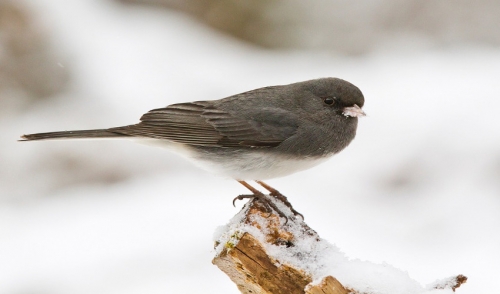{article.name}
Winter Birds to Watch for and How to Attract Them

- Share this:
- Share on Facebook
- Pin on Pinterest
- Tweet on Twitter
You may not be able to go out birding as often as you'd like in freezing temperatures and stormy days, but when these winter birds regularly visit your backyard, you may find that winter is your best birding season.
10 Most Anticipated Winter Birds
While many of your backyard birds will hang around all year, these species are more likely to be winter visitors and they can be a great surprise to see at your feeders.
- Dark-Eyed Junco: These energetic birds are easily recognized by their pale bills, dark hoods, and white outer tail feathers that flash when they fly. Juncos are often one of the first winter birds to arrive, and may be visiting feeders well before snow falls.
- White-Throated Sparrow: The bold white throat of this sparrow is a great field mark, but also look for a small yellow patch in front of the eye and the black-and-white striping on the head.
- Purple Finch: While many areas have these brown, streaky finches with a strong raspberry wash throughout the year, they are much more widespread in winter. Females lack the raspberry coloration, but both sexes may seem large and stocky.
- Red Crossbill: These heavyset finches have a distinctive criss-crossed bill that they use to pry into pine cones and open large seeds. Males are an allover rich red color, but females are a muted olive-yellow.
- Common Redpoll: These finches are tiny and have small, delicate yellow bills. The chin often shows a black patch, and the bright red cap on the head is distinctive. The body may be almost plain white or heavily streaked with blurry gray-black lines.
- Pine Siskin: These feisty finches are often confused for house finches, but the yellow patch that flashes on their wings is a great clue for proper identification. Also look for their sharply pointed bill and aggressive behavior at feeders.
- Evening Grosbeak: A relatively large songbird, the male evening grosbeak is highly sought after as a backyard visitor, and be sure to note his black-and-white wings and broad yellow eyebrow. Females are less boldly colored but still have a pale yellow bill.
- American Tree Sparrow: These sparrows may start arriving in late fall, and can be recognized by their chestnut cap, bicolored bill, and the dark spot in the center of their otherwise unmarked breast.
- White-Crowned Sparrow: Found in some places year-round, this boldly marked sparrow is much more widespread in winter and easily visits feeders. Look for the stark black-and-white head, pale bill, and spotted wing bars on this visitor.
- Cedar Waxwing: These fruit-loving birds are sporadic winter visitors, but travel in flocks and descend on fruit trees for sweet treats wherever they are found. The jaunty crest, creamy tan plumage, white and yellow underside, and black bandit mask are great identification clues.
Attracting Winter Birds
The exact birds you have visit your yard in winter will depend on how well you meet winter birds' needs for food, water, and shelter. To entice more winter visitors to your backyard…
- Food: Offer sunflower seeds, suet, and Nyjer (thistle) seed in several feeders, and keep ground-feeding areas clear for sparrows and juncos to enjoy. Platform feeders should be covered to keep off the snow, and large feeders can more easily accommodate hungry winter flocks.
- Water: Birds needs water just as much on cold days as they do on hot ones, and it takes a lot of energy for them to melt snow or ice to drink. Add a heater to your bird bath or invest in a heated bird bath to offer liquid water on the chilliest days, and be sure the bath is clean and full.
- Shelter: Birds seek out shelter during the harshest winter storms, and if your backyard provides safe shelter, they will take advantage of it. Evergreen and conifer trees are ideal, or you can build a brush pile in a sheltered location for birds to use. Roosting boxes are another option to keep birds safe and snug.
There are many great birds to look forward to in winter, and if you take steps to offer them the food, water, and shelter they need, you'll be surprised at how many different winter birds visit your backyard.



Comments